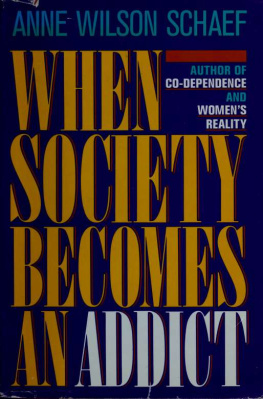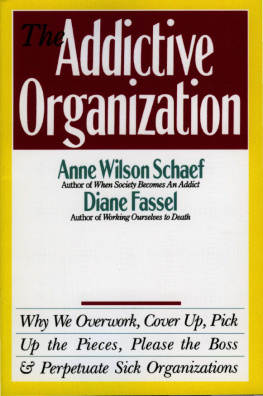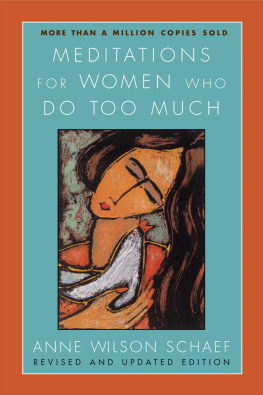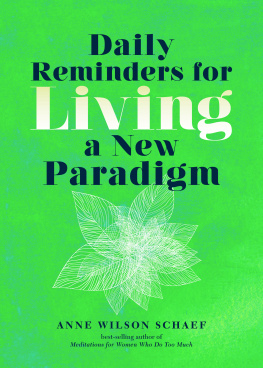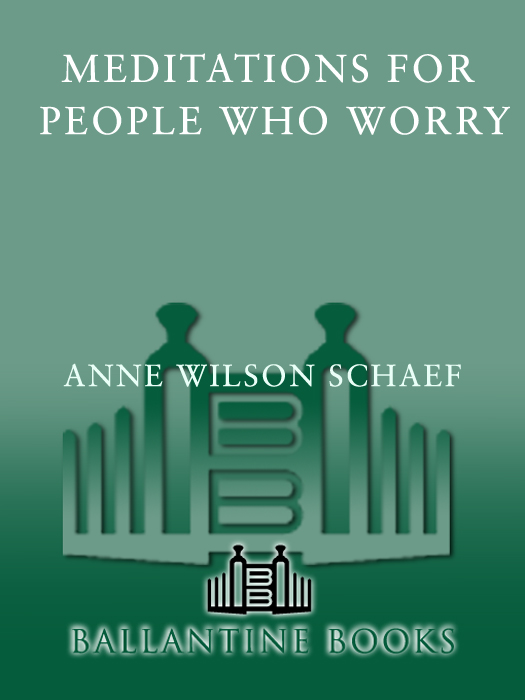A Ballantine Wellspring Book
Published by The Random House Publishing Group
Copyright 1996 by Anne Wilson Schaef
All rights reserved.
Published in the United States by Ballantine Books, an imprint of The Random House Publishing Group, a division of Random House, Inc., New York, and simultaneously in Canada by Random House of Canada Limited, Toronto. Originally entitled Meditations for People Who (May) Worry Too Much.
Ballantine Wellspring and the accompanying design are trademarks of The Random House Publishing Group, a division of Random House, Inc.
www.ballantinebooks.com
Library of Congress Cataloging-in-Publication Data
Meditations for people who (may) worry too much /
[compiled by] Anne Wilson Schaef.1st ed.
p. cm.
eISBN: 978-0-8041-5114-6
1. WorryReligious aspectsChristianity. 2. Devotional calendars.
I. Schaef, Anne Wilson.
BV4908.5.M36 1996
158. 12dc20 96-13685
v3.1
Contents
Introduction
Never, in a million years, could we have predicted the national and international success of Meditations for Women Who Do Too Much. True, it had a great title (and I had to fight over the title) which hit a nerve in American women and women around the world. Yet, I do not believe that the title alone could have made that book the million-plus international bestseller it is today. I have received so many letters from women the world over stating how helpful this book has been and what a daily companion it has become. I feel especially gratified about this response because this little book represents the first time I ventured forth with my philosophy of life and the way of living I am teaching in the Living in Process work. My previous books were more focused upon my observations of the world around me, with hints of my personal philosophy. In Meditations for Women Who Do Too Much, I put my beliefs on the line and they resonated.
I had thought of writing a sequel, Meditations for Women Who Are Recovering from Doing Too Much. Yet, I wanted to get on with something new (Im an Aries).
Then I sat down and thought, What else do people in this culture do that robs them of their ability to be fully alive as much as doing too much does? Then it hit meworry. Worry is a national and an international pastime. Yet, no worrier wants to worry about whether or not they worry too much. Somehow, worrying doesnt have the same status as doing. So, I decided to write a book for people who may worry too much.
I did not personally know of many quotes on worry and the quotation books seemed woefully bare on this topic. Then I asked the Living in Process Network to send me ideas and thoughts they had on worry. I began to listen to what people said in conversations and I put out the word that I wanted quotes about worry. The result has been a deluge. Indeed, worry seems to be a favorite way to while away hours (days, weeks, yearslifetimes). In a few short months, I had more quotations on worry than I could possibly use. I found out some interesting ideas about worry. Generally, information about worry seemed to break down into two general categories: 1) the process of worrying, and 2) the content of worrying. The process of worrying includes such issues as how people worry, when they worry, where they worry, and how worry affects them. The content of worrying is what people worry aboutwell, almost everythingchildren, money, self-esteem, health, what other people think of them, the weather, promotions, the future, the past, the present. You name it and someone is worrying about it at this very minuteas we speak.
I did not want to get too scientific about worryactually I dont want to get too scientific about anythingand I did find it interesting to look at processes, topics, and trends. We are a nationyea, a worldof worriers.
I have to admit that I have not worried much about this book. I decided to let this book worry itself into being. Also, I want to say that I have played with the concept of worry. I know that it is a serious business for those who do itespecially those who do it a lotand I always find it very healing to laugh with myself and others, and for us to play with ourselves. As I have said before, with the rise of Western psychology and psychotherapy, we have tended to put our garbage on the altar, see it as sacred (only the paid professional priests and priestesses dare to look at it and pick through it, and even they are sworn to secrecy!!), and worship it. Enough! Lets look at what we do, laugh at our foibles, share them with others, learn from them, and move on with the living of our lives.
I hope this little book hits a nerve, too, and offers a possibilitya possibility for living, which is, after all, what we are here to do.
JANUARY 1
Worry
It is estimated that more than thirteen million American adults are chronic worriers. The National Institute of Mental Health says anxiety disorders are Americas most commonly reported mental-health problems.
AMY H . BERGER
My goodness. Do you think that this means thirteen million people need this book? I hope so!
Seriously, though, we seem to have developed an epidemic and we dont even know it. Almost everyone seems to worry about something and, yet, we rarely talk about worry as a problem. Maybe that is because worry is so integrated into the way we have come to live and be in the world that we dont even notice it.
There are many facets to worry. Worry is not simple nor is it simply addressed. We could worry about worry and then worry about our worrying about worry. But, why chase our tails.
Clearly, we need to explore worry, we need to understand worry, we need to share experiences and wisdom about worry. And, most of all, we need some relief from worry. Its a new year and we have 366 daily meditations to feed and heal us.
Theres a certain solace in knowing that I am not alone: I have thirteen million worriers to keep me company.
JANUARY 2
Being Ourselves
Strangulation or choking is the first definition of WORRY in Websters Ninth New Collegiate Dictionary, which details its roots in German, French, and English with that meaning. WORRY can immobilize or choke the WORRIER and/or the WORRIEE (the person about whom one worries).
BETSY MARTIN
To choke myself. To choke others. How often we have tried to make ourselves less than we are in ways so subtle that we are not even aware of them.
We often feel that we are too big for others to handle and if we just reduce who we are and make ourselves small and insignificant we will not be a threat to others who are doing the same thing, unbeknownst to us or themselves.
When I choke myself, I tend to choke my family, my friends, my co-workers, everyone around me. When I choke those around me, I almost always then have to choke myself.
I can be as big as I am without worrying about stepping on anyones toes. If others have a problem with this, it is, after all, their problem. I need to respect that they can handle it.
JANUARY 3
One-Track Minds
Thoughts are energy. And you can make your world or break your world by thinking.
SUSAN TAYLOR


